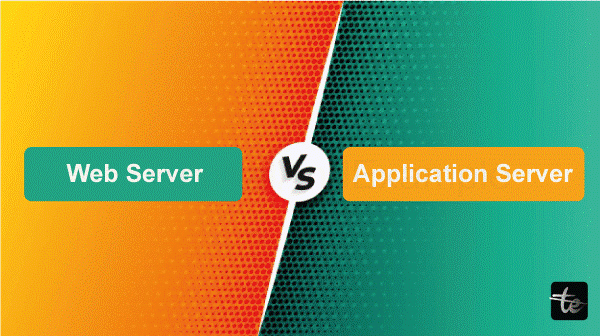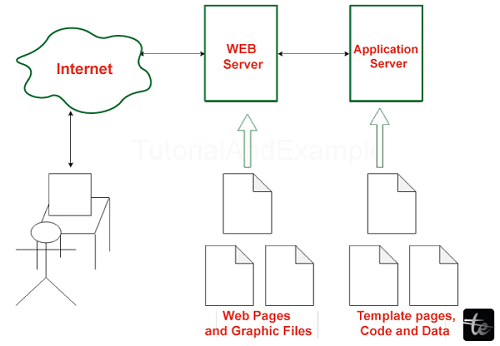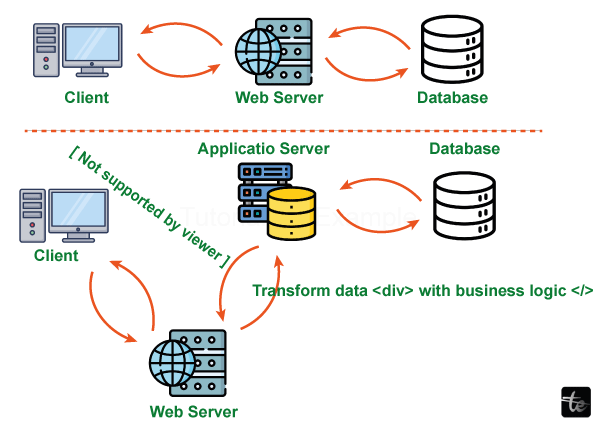Difference between Web Server And Application Server
Introduction

A server is an administrative centre on an internet connection where data and computer programs are stored and accessible by programmers. Two types of servers are used to offer websites: web servers and software servers. The latter handles application activities that take place alongside users and the company's back-end application software. A server is a centralized point from which apps on an internet connection can access and store data and programs. While a Software Server also includes an EJB wrapper component to execute business applications, a web Server is a server that receives requests for information and responds with the appropriate content. In this article, we are going to have detailed information about the difference between web server and application server.
What is a Web Server?
A web server is a gadget or program that receives an email asking for data and delivers all the files that are requested. The web server could be an appliance that stores content for the internet. In essence, internet computers are used to host websites, but there are other types of server hardware as well, like leisure activities, keeping, FTP, email, etc.

A web server is characterized as a device that receives an inquiry for information and responds with the appropriate document. Put otherwise, it's a computer program that responds to a demand for something in particular and delivers it to the consumer's computer. The purpose of internet servers is to provide HTTP content to client computers. The web servers are often the essential components of the application's platforms. After accepting requests made via HTTP, web servers translate them and provide the desired information.
Web servers are meant to deliver static content, but most of them can also produce dynamic HTTP content by using plugins that enable programs like PHP, Perl, and others.
How Do They Work?
Assume we have a web server-hosted staff management webpage on the college's website. Let's say a staff member has to fill out the staff administration website with their information. The employee opens a browser for the internet on their browser, such as Firefox from Mozilla or Google Chrome, and types a web address

This corresponds to a demand for HTTP that is made to the web server in question. The client's request is handled by the web server, which then retrieves the particular HTML page. In response, the employee administration of the system's webpage is shown on the client's gadget by the web server.
Although web servers only have to store and display web pages, they don't need as many resources as application servers do. In addition, tolerance for faults should be emphasized in the layout.
Example of Web Servers
- Apache Tomcat
- Resin
What is an Application Server?
A server that is intended to produce continually changing information is called an application server. It's a software framework that modifies data to enable certain features that a company, service, or program offers. According to the request's context, application servers improve a web page's user experience.
Web packaging and EJB containers are found in the application servers. Enterprise application environments are entirely the responsibility of the application servers. These servers can provide RPC/PMI protocols in addition to HTTP. Compared to website servers, application servers need higher computational power and memory resources.

Since a Web Server is typically an important component of an Applications Server, the application Server is capable of carrying out all the functions of the Internet Server.
How Do They Work?
Let's return to the academic network instance to see how an app server operates. Let's say college student X needs to use a word processor. To launch the word editing program, the learner interacts with a graphical user interface. The program's server receives the following demand to grant permission to access user X's device

Following receipt of the demand, the server produces a response for the client. Access to a spreadsheet program would be the proper response in this situation. Student X's device receives the reply, at which point the pupil can utilize the word generator.
The application server is designed to manage several requests at once, utilizing load balancing because of the kinds of requests it receives and the quantity of programs it hosts. Furthermore, an app server is designed for being, enabling it to continue operating normally even in the event of a fault.
Examples of Application Server
• Weblogic
• JBoss
• Websphere
Difference between Web Server and Application Server
| Web Server | Application Server |
| Typically, a web container is present in a web serverWhen it comes to static material, such as static HTML pages, a web server works well.Utilisation of ResourcesWhen comparing the amount of memory and CPU use, a web server uses less than an application server.The runtime environment used by websites is provided by a web server. There needs to be an implementation for multithreading.HTTP Protocol is supported by web servers.Apache Web Server as an instance. | A Web Containers and an EJB Container are both part of an Application ServerAn application server is important for dealing with dynamic content, such as websites run by banksA server for programs uses additional resources. The intended settingof company applications' runtime settings is supplied by application servers.There is implementation for multithreading..RPC/RMI protocols are supported by application servers in addition to HTTP.For instance.WebLogic, Java Beans. |
Web server vs. application server
A web server is an application server's shared component by formal meaning.
Web servers typically respond to queries made by web browsers using the hypertext transfer protocol (HTTP) to deliver basic internet materials such as files, photos, and videos.
Although a software server's main responsibility is to facilitate interactions between end-user clients and server-side utilization code—the algorithms that represent what is frequently referred to as business logic—it can also normally deliver web pages. Through this relationship, dynamic content, such as transaction results, choice support, or real-time analytics, can be generated and delivered. A browser for the internet, a smartphone app, or the application itself itself itself can serve as the clientfor a server that runs the application. Various forms of communication can be used to facilitate client-server communication.The distinction among web servers and application servers has, however, become increasingly hazy in practise, especially as web browsers have grown to be the most common application clients and as consumer demands for web-based applications and their efficacy have increased.
Most web servers allow scripting plug-ins (such as those for ASP, JSP, PHP, and Perl) to be used by the web server to generate dynamic material using client-side logic. Furthermore, a growing number of application servers currently support additional protocols (such as CGI and its variations) for interacting with websites in addition to having internet connection features and using HTTP as their primary interface. Additionally, they enable web-based applications to take advantage of load sharing, redundant operation, aggregation, and reverse proxy, which enhance performance and dependability and let programmers.
To further complicate the situation, many web servers and some application servers refer to one another or themselves as web application servers. Ultimately, the most widely used web and application servers available today are combinations of the two. A variety of web server and application server technologies are used to offer both dynamic and static information in the majority of the more complex programs you encounter today.
Key Differences between Application servers and Web servers
- Purpose: The purpose of application servers is to enable complex programs and company logic, whereas internet servers are meant to offer static information and websites.
- Scalability: Application servers are built to manage high traffic volumes and are vertically scalable, whereas web servers are often horizontally expandable and can only cope with small amounts of traffic.
- Security: While application servers offer extensive protection features and facilitate safe transactions, web servers usually provide minimal protection.
- Database interaction: While web servers are capable of some network interaction, application servers offer more sophisticated functionality for talking to and communicating with systems.
- Middleware: Web servers do not offer gateway functions like managing transactions, security, and caching, whereas application servers do.
- Performance: While application servers are optimized for handling complicated company reasoning and database communications, web browsers are designed to offer static information rapidly.
- Complexity: While application servers require higher knowledge of technology to set up and upkeep, web servers are typically easier to establish and manage.
Conclusion
Based on the discussion above, we can say that an application server is a computer program that helps us host programs and offers an atmosphere in which an application program may be developed and run. In contrast, a web server is a computer program that receives HTTP requests from clients and sends the desired information.
It should be evident that web servers and application servers share specific capabilities and are not inherently better than one another. To allow reliable and flexible effectiveness, it is frequently practical to couple an application server, such as Tomcat or Zend Server, with a web server, such as Apache or NGINX, according to your requirements or use situation.